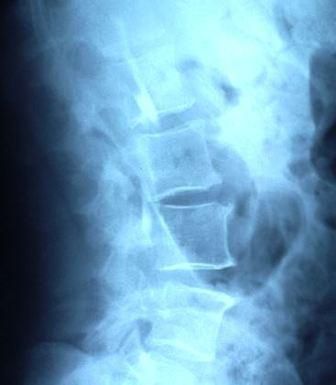Discitis in an HIV-Positive Man
Discitis, a bacterial infection within the vertebral disc, typically results from seeding during an episode of bacteremia.

A 46-year-old man with a history of HIV infection presents to the emergency department for left flank pain. He has had this same pain 3 times in the past year, and each time he was given a diagnosis of pyelonephritis and was treated with antibiotics. Each time he improved, but the pain gradually returned. The most recent episode was about 3 months ago.
Today the patient’s symptoms are identical to those in the previous episodes. They include 4 or 5 days of left-sided back pain, low-grade tactile fevers, and urinary frequency. He denies nausea, vomiting, abdominal pain, hematuria, and dysuria and states that he feels he can empty his bladder completely without straining. He has no lower extremity symptoms or other complaints.
On examination, the patient’s vital signs are all normal, including an oral temperature of 37.2°C (98.9°F). The results of his head and neck examination are normal, and he has no thrush. His lungs are clear, with normal oxygen saturation, and his heart rate is regular without murmurs. The results of his abdominal examination are benign, but he definitely has left costovertebral angle (CVA) tenderness as well as some midline spinal tenderness. His strength and sensation are normal in both legs and both arms. The rest of the examination findings are normal.
Laboratory data show a white blood cell (WBC) count of 9.8 x 103/µL, with 77% neutrophils. The metabolic panel is normal. Urinalysis (UA) shows negative nitrites, 48 WBCs, and no red blood cells.
A lateral x-ray film of the patient’s lumbar spine is shown above.
What is the differential diagnosis? .
What is the most likely diagnosis?
What other information might be useful to make the diagnosis correctly?
What is the differential diagnosis? Recurrent pyelonephritis, prostatitis, renal abscess, resistant pyelonephritis, discitis, epidural abscess.
What is the most likely diagnosis? Given the x-ray findings (see below), discitis.
What other information might be useful to make the diagnosis correctly? The presence or absence of bacteria in the UA. The results of previous urine cultures.
X-ray Findings
The plain x-ray film shows erosion of the anterior vertebral end plates both above and below the involved disc space, consistent with discitis. Discitis can cause a false-positive UA finding because of sympathetic pyuria. The patient’s UA did not show the presence of bacteria, making a diagnosis other than urinary tract infection (UTI) more likely. His previous urine culture results were all negative, making urine infection even less likely.
DISCUSSION
Discitis, a bacterial infection within the vertebral disc, typically results from seeding during an episode of bacteremia. Therefore, it is most common in injection drug users, pediatric patients, patients with indwelling catheters, and patients with endocarditis. Rarely, discitis results from direct spread from a nearby focus of infection, especially after recent surgery. It invariably coexists with some degree of osteomyelitis, usually affecting the end plates of both of the adjacent 2 vertebral bodies. Because of blood supply, the lumbar spine is the most frequently involved segment, followed by the thoracic spine and then the cervical spine.
The classic clinical triad of discitis is (1) back or spinal pain, often worse at night; (2) fever; and (3) spinal tenderness. However, fever may be low-grade and actually is absent in about 50% of cases, especially early in the disease process.
Disease progression often is insidious and symptoms often have been present for well more than a month by the time the diagnosis is made. However, progression can become more rapid if epidural or paraspinal abscess, sepsis, vertebral body collapse, or other complications occur.
Testing
Testing often reveals a leukocytosis. However, an elevated erythrocyte sedimentation rate or C-reactive protein level is more sensitive, being positive in about 80% of cases, and serial values are useful in determining response to therapy.
X-ray film findings are often negative until the disease has been present for 4 weeks, when bony changes to the nearby vertebral bodies may be seen. MRI is the most sensitive imaging test, but CT or bone scans may be used when MRI is contraindicated or unavailable.
Determining the causative organism is important for deciding on the treatment. In stable patients, antibiotic therapy generally should not be initiated until after discussion with the spine surgeon or infectious disease specialist who will be consulting on the case.
Bone cultures via biopsy are the most sensitive test for determining the causative organism, but blood cultures are positive in about 60% of cases and are less invasive. Staphylococcus aureus is the most common pathogen recovered, followed by enteric gram-negative organisms after UTI or genitourinary/GI procedures. Pseudomonas is common in drug users and patients with indwelling lines. Other common organisms include Streptococcus (group B, C, or G), Candida and, in certain populations, Mycobacterium tuberculosis.
Treatment
Treatment is 6 to 12 weeks of antibiotics, usually given via a peripherally inserted central catheter unless quinolone-sensitive organisms are recovered. Surgery may be required if there are complications such as those listed above or if the response to antibiotics is inadequate. Evaluation for endocarditis should be considered in at-risk patients or those with a murmur or other clinical signs of the disease.
Multiple clues in this patient’s clinical presentation alerted the clinician that he might not have pyelonephritis but rather something more sinister. His injection drug use and history of recurrent presentations both were suggestive of the possibility of another process. In addition, pyelonephritis developing in a male patient of his age is not common. Also, on physical examination, his left CVA was not the only area of tenderness. If one did not stop there, some mild but focal spinal tenderness also could be elicited.